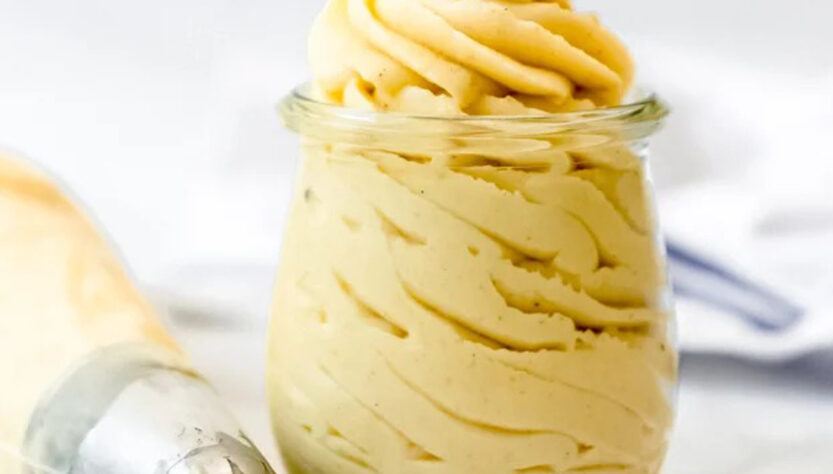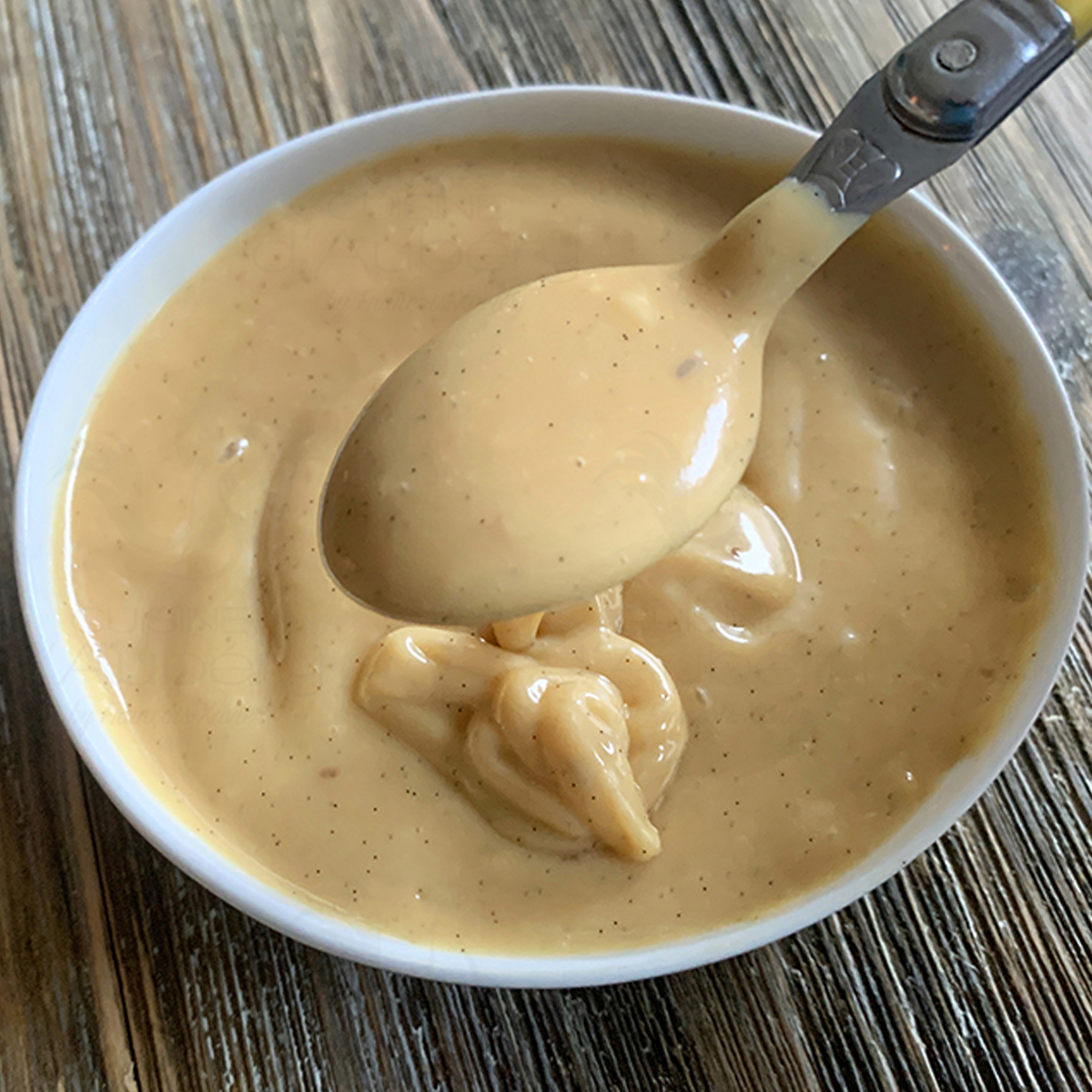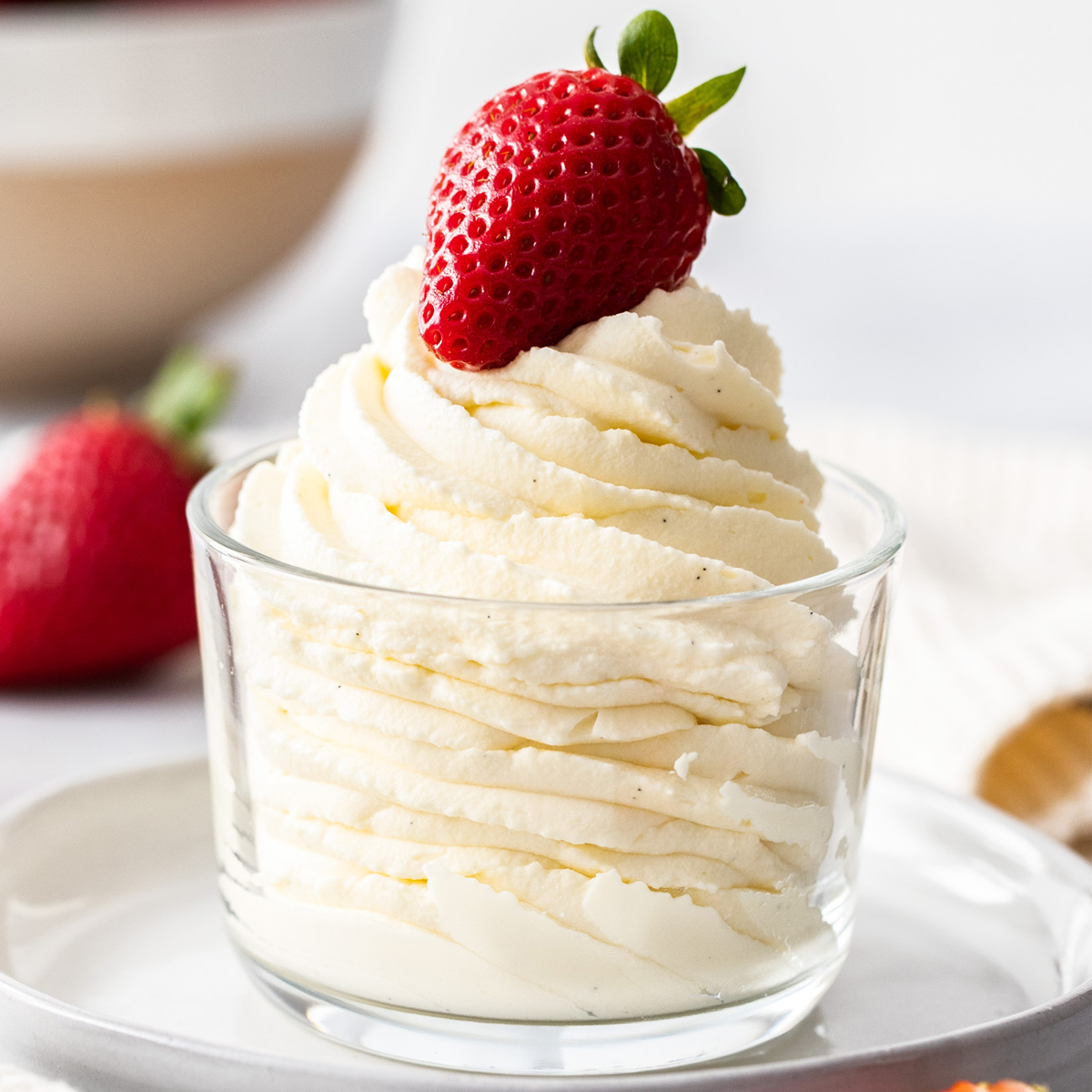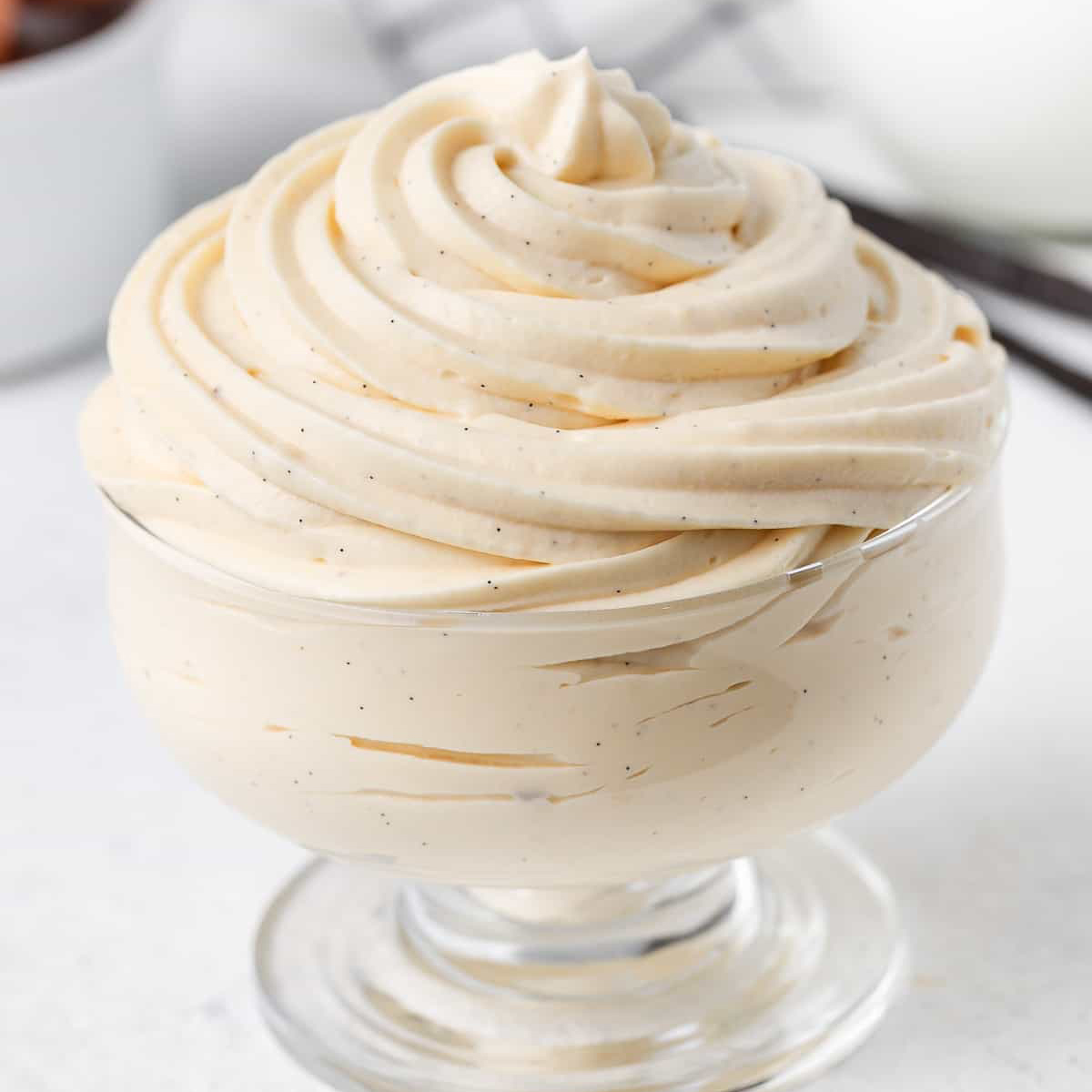Step into the enchanting world of French pastry with the exquisite delight known as French Pastry Cream. Also referred to as “Crème Pâtissière” in its home country, this velvety custard serves as the cornerstone for countless iconic French pastries. With its luscious texture, delicate sweetness, and captivating vanilla aroma, French Pastry Cream elevates desserts to an unparalleled realm of indulgence.
Imagine a dessert universe where éclairs, fruit tarts, cream puffs, and Napoleons reign supreme, each graced by the ethereal touch of this cream. French Pastry Cream is the luxurious binding agent that harmonizes layers, fills hollows, and bestows an irreplaceable richness upon every bite. Its origins trace back through centuries of refined culinary tradition, showcasing the French commitment to balancing elegance and flavor in every creation.
In the following exploration, we delve into the art of crafting this quintessential custard. Unveiling its delicate balance of egg yolks, milk, sugar, and the enchanting embrace of vanilla, we unlock the secrets behind achieving the perfect consistency, flavor, and velvety mouthfeel. Whether you’re embarking on your first foray into French pastry or seeking to master this cornerstone element, the journey into the heart of French Pastry Cream promises to be as rewarding as it is delectable.
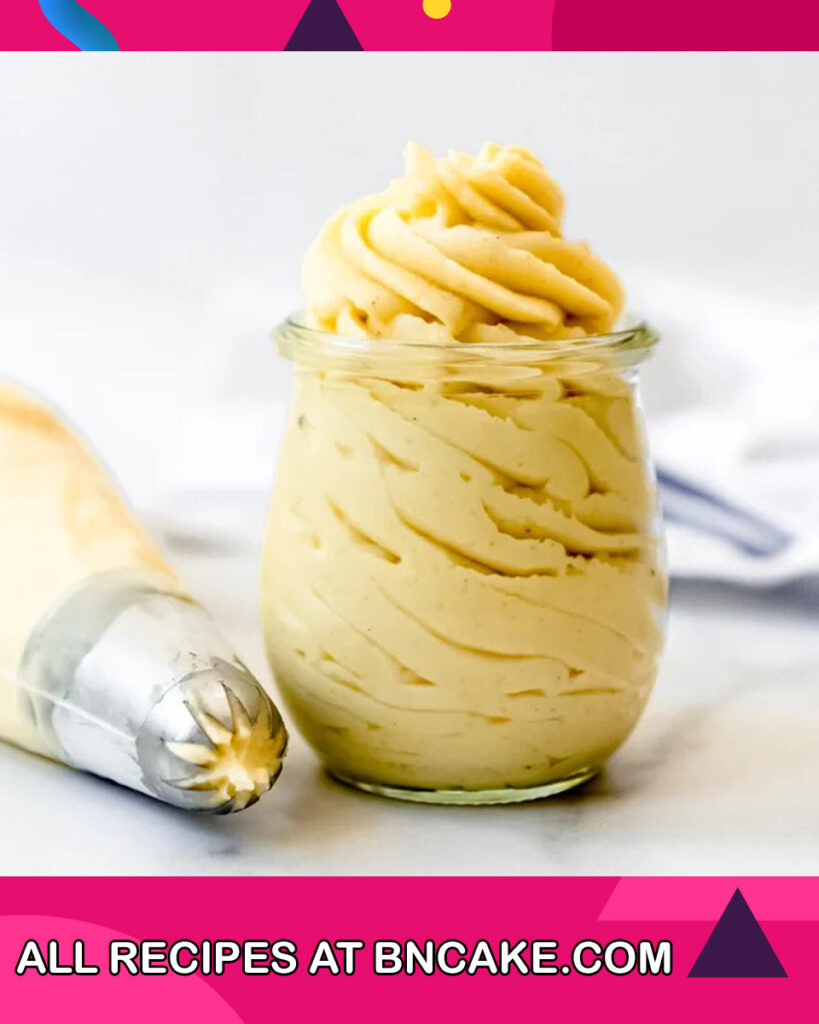
What Is French Pastry Cream?
French Pastry Cream, also known as “Crème Pâtissière” in French, is a classic custard-like filling used in a variety of French desserts and pastries. It serves as a fundamental component in creating luscious and indulgent treats. This creamy and velvety mixture is made from a combination of milk, egg yolks, sugar, and flavorings, typically vanilla. It’s often enriched with butter to further enhance its richness and texture.
French Pastry Cream is renowned for its versatility and ability to elevate a wide range of desserts. It’s a staple in pastries like éclairs, cream puffs (profiteroles), fruit tarts, Napoleons (mille-feuille), and Danish pastries. Its smooth consistency and delightful sweetness make it an ideal filling for creating layers or filling the hollows of various baked goods.
To prepare French Pastry Cream, milk is heated until almost boiling, then tempered egg yolks and sugar are gradually added while whisking to create a smooth custard base. This mixture is then cooked until thickened, resulting in a luxurious cream that can be flavored with vanilla, chocolate, coffee, or other extracts, depending on the desired end product.
French Pastry Cream not only contributes flavor but also provides stability and structure to pastries, making them both visually appealing and delightful to the palate. Its usage varies from acting as a filling to being a base for other cream-based desserts. The delicacy and versatility of French Pastry Cream have made it a cornerstone of French pastry artistry, and its creation is a skill cherished by bakers and pastry chefs around the world.
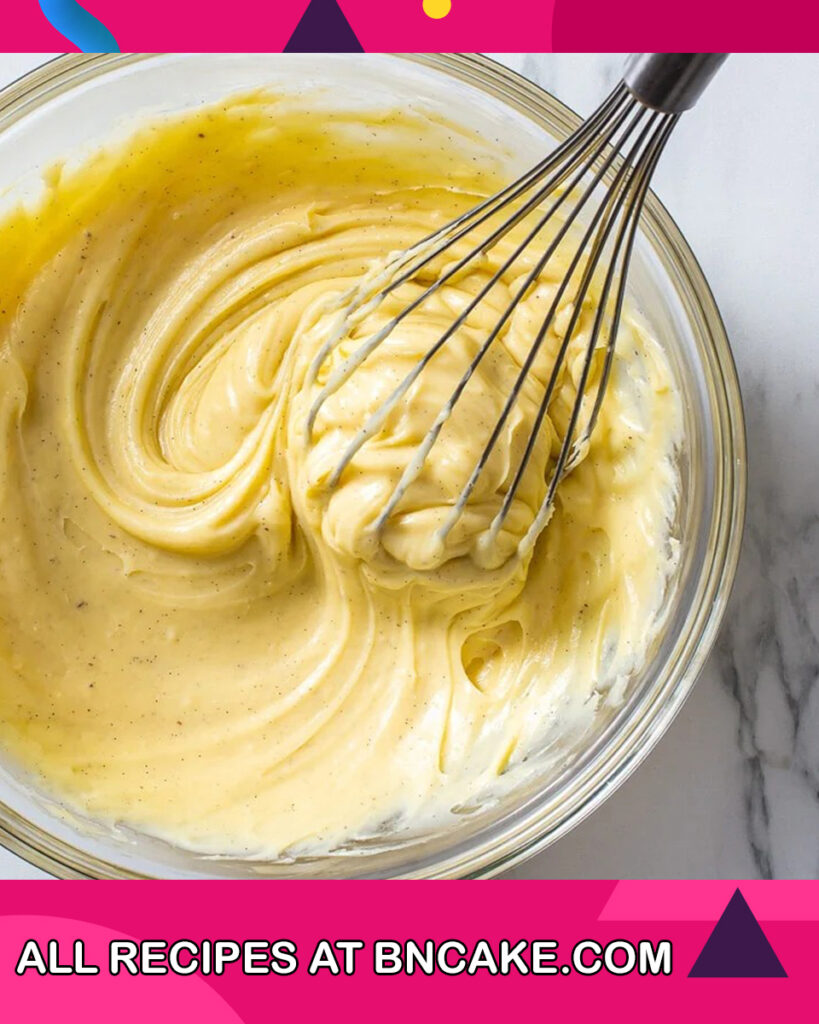
Why You Will Love French Pastry Cream Recipe?
- Classic Elegance: French Pastry Cream embodies the timeless elegance of French pastry artistry. Its velvety texture and delicate flavor add sophistication to a wide range of desserts.
- Versatile Creation: The recipe serves as the foundation for an array of delectable pastries. From éclairs to tarts and cream puffs, you’ll have a versatile canvas to create an assortment of irresistible treats.
- Rich Creaminess: The smooth, creamy consistency of French Pastry Cream is pure indulgence. Its velvety mouthfeel elevates every bite, making you savor the luxurious experience.
- Personalization: While vanilla is the classic flavoring, you can infuse the cream with other flavors like chocolate, coffee, citrus, or almond, allowing you to tailor the cream to your taste preferences.
- Key Ingredient: As the heart of iconic French pastries, mastering the creation of French Pastry Cream opens the door to creating authentic and exquisite desserts that impress both the eye and the palate.
- Showstopper Desserts: Whether it’s a luscious fruit tart, an elegant Napoleon, or a profiterole tower, your creations will turn heads and elicit admiration at any gathering or event.
- Culinary Craftsmanship: Preparing French Pastry Cream hones your culinary skills. Achieving the perfect consistency and mastering the cooking process is a rewarding journey that enhances your baking expertise.
- Sharing Joy: Serving pastries filled with homemade French Pastry Cream is a gesture of joy and warmth. Sharing these delectable treats with loved ones becomes a moment of culinary generosity.
- Sense of Accomplishment: Successfully crafting this foundational element of French pastry gives you a sense of accomplishment, as you’ll have gained a skill that can be used to create countless delightful desserts.
- Memories in the Making: From the process of whisking the ingredients to the final presentation, every step of making French Pastry Cream is an experience to cherish. Your kitchen will be filled with the aroma of sweet nostalgia.
Embrace the journey of creating French Pastry Cream, and you’ll discover that it’s not just a recipe, but a gateway to a world of elegant desserts that reflect the artistry of French baking traditions. With each bite, you’ll taste the history, craftsmanship, and passion that have made this cream a beloved treasure in the culinary realm.

Ingredients For French Pastry Cream
- 2 cups whole milk
- 1/2 cup granulated sugar
- 1/4 cup cornstarch
- 4 large egg yolks
- 1 teaspoon vanilla extract
- 2 tablespoons unsalted butter
How To Make French Pastry Cream
- Prepare the Ingredients:
- Ensure that the egg yolks are at room temperature. This helps in achieving a smoother custard texture.
- Measure out the milk, granulated sugar, cornstarch, vanilla extract, and unsalted butter before starting the cooking process.
- Warm the Milk:
- In a saucepan, heat the whole milk over medium heat until it starts to steam. Do not let it come to a boil; you just want it to be warm. This step prepares the milk for blending with the egg mixture.
- Combine Sugar and Cornstarch:
- In a mixing bowl, whisk together the granulated sugar and cornstarch until they are well combined. This mixture will help thicken the pastry cream.
- Whisk the Egg Yolks:
- Add the large egg yolks to the sugar-cornstarch mixture. Whisk vigorously until the mixture becomes smooth and slightly pale in color. This step incorporates air into the yolks for a silky texture.
- Temper the Eggs:
- Gradually pour about half of the warm milk into the egg mixture while whisking continuously. This tempering step prevents the eggs from curdling when mixed with the hot milk.
- Combine the Mixtures:
- Pour the egg and milk mixture back into the saucepan with the remaining warm milk. This brings together the creamy egg mixture with the warmed milk.
- Cook the Custard:
- Place the saucepan over medium heat. Constantly whisk the mixture as it heats. The mixture will start to bubble and thicken. Continue whisking to ensure even cooking and prevent lumps.
- Add Vanilla and Butter:
- Once the mixture has thickened to a custard-like consistency, remove the saucepan from the heat. Stir in the vanilla extract and unsalted butter. The butter adds richness and glossiness to the cream.
- Strain the Cream (Optional):
- For an extra smooth texture, you can strain the pastry cream through a fine mesh sieve into a clean bowl. This removes any potential bits of cooked egg or lumps.
- Prevent Skin Formation:
- To prevent a skin from forming on the surface, place a piece of plastic wrap directly on the surface of the pastry cream. This ensures that the cream remains smooth.
- Chill and Set:
- Allow the pastry cream to cool to room temperature. Then, refrigerate it for at least 2 hours, or until it’s thoroughly chilled and set.
- Stir Before Use:
- Before using the pastry cream in your desired pastries or desserts, give it a good stir to ensure a creamy and consistent texture.
Embrace the art of French pastry with this sumptuous French Pastry Cream. Its velvety allure and delicate sweetness will elevate your creations to new heights of culinary excellence.
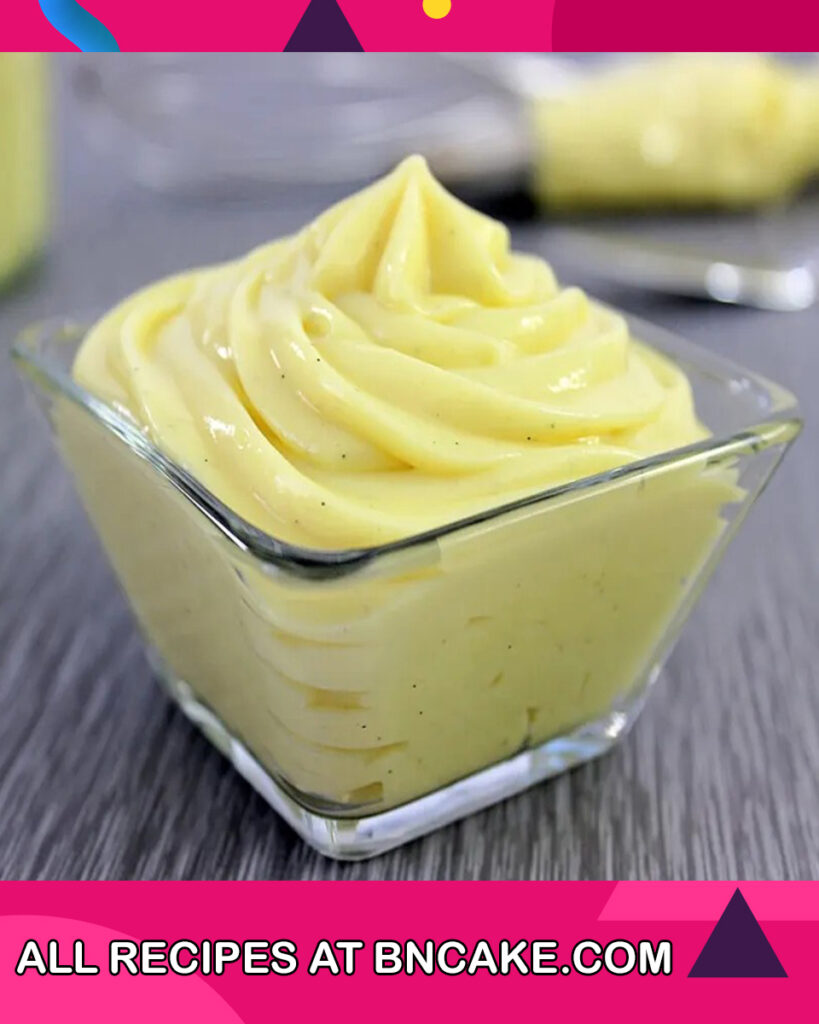
How To Serve French Pastry Cream
Serving French Pastry Cream is a delightful endeavor that lets you showcase its luxurious texture and delicate flavor. Whether as a standalone dessert or a filling for various pastries, here’s how to serve French Pastry Cream with finesse:
As a Standalone Dessert:
- Chilled Perfection: Ensure that the French Pastry Cream has been properly chilled and set in the refrigerator for the recommended time. It should be firm and velvety.
- Elegant Presentation: Choose serving vessels that highlight the cream’s texture and elegance. Small glass cups, dessert bowls, or decorative dishes work well.
- Layering Options: Create layers of delight by alternating spoonfuls of French Pastry Cream with layers of fresh berries, sliced fruit, or crumbled cookies. This adds visual appeal and complementary flavors.
- Garnish Gracefully: Sprinkle a dusting of cocoa powder, powdered sugar, or finely grated chocolate over the cream’s surface for a touch of elegance.
- Fresh Fruits: Serve the pastry cream with a side of fresh berries, sliced kiwi, or citrus segments. The natural sweetness of the fruits pairs beautifully with the cream.
As a Filling for Pastries:
- Pastry Selection: Choose pastries that pair well with the flavor and texture of French Pastry Cream. Options include éclairs, cream puffs, fruit tarts, Napoleons, and Danish pastries.
- Piping Filling: If using French Pastry Cream as a filling, use a pastry bag with a round or star tip to pipe the cream into the pastry shells. This adds a neat and elegant touch.
- Dress with Decor: Enhance the visual appeal by drizzling a thin layer of chocolate glaze or ganache over the filled pastries. It creates a glossy finish and adds another layer of flavor.
- Create Layers: In pastries like Napoleons, layer sheets of puff pastry with French Pastry Cream. Top the final layer with a dusting of powdered sugar or a thin glaze.
- Individual Portions: For gatherings, consider creating individual portions of filled pastries. Arrange them on a platter for a charming and delectable presentation.
- Sprinkle Elegance: Add a touch of luxury by sprinkling edible gold or silver dust over the filled pastries. It’s a visually stunning addition.
Accompaniments:
- Beverages: Serve French Pastry Cream with beverages like espresso, coffee, tea, or a dessert wine. The pairing enhances the dessert experience.
- Whipped Cream: A dollop of lightly sweetened whipped cream alongside the pastry cream can add a lovely contrast in texture and flavor.
- Mint Leaves: Garnish with a sprig of fresh mint leaves for a burst of color and a hint of herbal aroma.
Serve with Style:
Present your French Pastry Cream creation with care and attention to detail. Use complementary colors, textures, and garnishes to make each serving a work of art. The experience of savoring the delicate flavors and creamy texture of French Pastry Cream will surely be a memorable culinary journey for you and your guests.
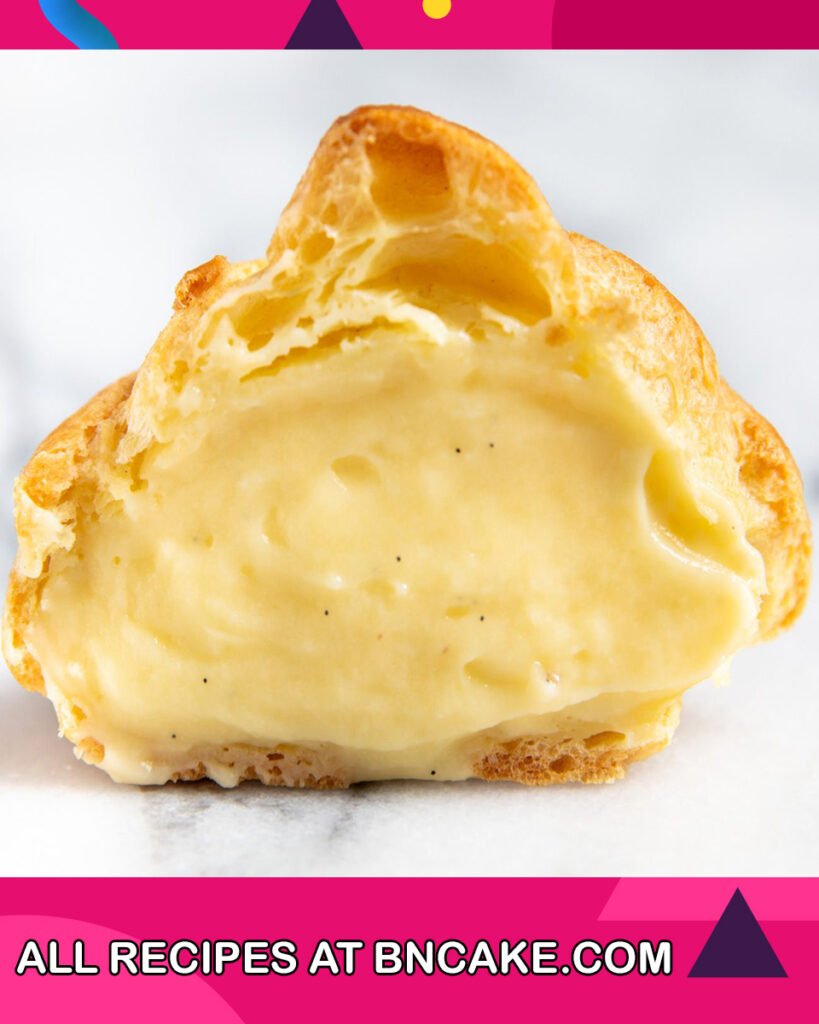
How To Store French Pastry Cream
Storing French Pastry Cream properly is essential to maintain its freshness and quality. Whether you have leftover cream or are making it in advance, here’s how to store French Pastry Cream:
Short-Term Storage:
- Cooling: After preparing the French Pastry Cream, allow it to cool to room temperature before storing. This helps prevent condensation from forming inside the storage container.
- Airtight Container: Transfer the pastry cream to an airtight container. Glass or plastic containers with tight-fitting lids work well. Ensure that the container is clean and dry before adding the cream.
- Surface Protection: To prevent a skin from forming on the surface of the cream, press a piece of plastic wrap directly onto the surface before sealing the container. This creates a barrier that prevents air from coming into contact with the cream.
- Refrigeration: Place the airtight container in the refrigerator. French Pastry Cream can be stored in the refrigerator for up to 3-4 days. However, for the best quality and texture, try to use it within 2 days.
Long-Term Storage (Freezing):
If you need to store French Pastry Cream for a longer period, you can freeze it. Here’s how:
- Cool and Package: Follow the steps for cooling and placing the cream in an airtight container, as mentioned above.
- Portioning: If you anticipate using smaller amounts at a time, consider portioning the cream into smaller containers before freezing. This way, you can thaw only what you need.
- Freezing: Seal the containers tightly and label them with the date. Place them in the freezer. French Pastry Cream can be frozen for up to 2 months.
Thawing and Using:
- Thaw Gradually: To thaw frozen French Pastry Cream, transfer it from the freezer to the refrigerator. Allow it to thaw gradually in the refrigerator over several hours or overnight.
- Stir Before Use: After thawing, give the cream a good stir to ensure it regains its smooth and creamy texture. If needed, you can reheat it gently over low heat while stirring constantly. Avoid high heat to prevent curdling.
Note: While freezing is an option, please be aware that the texture of the cream may change slightly after thawing. It’s best to use frozen pastry cream in recipes where its consistency will be less noticeable, such as fillings for pastries.
By following these storage guidelines, you can ensure that your French Pastry Cream remains fresh, safe to consume, and ready to enhance your desserts whenever you’re ready to use it.
HERE ARE SOME OTHER RECIPES YOU MIGHT LIKE!
Tips And Tricks For French Pastry Cream
Here are some valuable tips and tricks to help you achieve the best results when making and working with French Pastry Cream:
1. Temper the Eggs Carefully:
When combining the warm milk with the egg yolk mixture, do it gradually and whisk continuously. This process, called tempering, prevents the eggs from curdling due to sudden temperature changes.
2. Use a Heavy-Bottomed Saucepan:
Choose a heavy-bottomed saucepan for cooking the pastry cream. This helps distribute heat evenly and reduces the risk of scorching.
3. Constant Whisking:
While cooking the pastry cream, ensure you whisk constantly to prevent lumps from forming. Pay special attention to the bottom and corners of the saucepan.
4. Smooth Consistency:
If you notice any lumps in your pastry cream, you can strain it through a fine mesh sieve after cooking. This will give you a silky smooth texture.
5. Avoid Boiling:
Do not let the milk come to a full boil when warming it up. Instead, heat it until it starts to steam, and then remove it from the heat. Boiling can cause the milk to scorch and affect the flavor.
6. Butter Adds Richness:
Incorporate the butter into the pastry cream while it’s still warm. The heat will help the butter melt and blend seamlessly, adding richness and glossiness.
7. Preventing Skin Formation:
To prevent a skin from forming on the surface of the pastry cream as it cools, press a piece of plastic wrap directly onto the surface. This prevents air from coming into contact with the cream.
8. Vanilla Enhancement:
For an even stronger vanilla flavor, consider using a vanilla bean instead of vanilla extract. Split the vanilla bean and scrape out the seeds, then add both the seeds and the pod to the milk as it warms up.
9. Storage Techniques:
When storing, always use airtight containers to prevent the pastry cream from absorbing any off-flavors in the fridge. If freezing, portion the cream into smaller containers for easier thawing.
10. Reheating Gently:
If your pastry cream becomes too thick or has been chilled for a while, you can gently reheat it over low heat while stirring constantly. Be careful not to overheat, as this can cause curdling.
11. Flavor Variations:
Experiment with different flavor variations by infusing the milk with herbs, spices, or citrus zest. Just remember to strain the milk before combining it with the egg mixture.
12. Freshness Matters:
French Pastry Cream is best when it’s freshly made. While it can be stored, the texture may change slightly upon reheating or after being refrigerated or frozen.
13. Double Boiler Method:
For an extra cautious approach, you can use a double boiler (bain-marie) to cook the pastry cream. This reduces the risk of overheating or scrambling the eggs.
14. Use in a Timely Manner:
If using the pastry cream as a filling, it’s best to fill your pastries shortly before serving. This ensures that the cream retains its texture and doesn’t soften the pastry prematurely.
Mastering French Pastry Cream opens up a world of elegant desserts and pastries. By following these tips and techniques, you’ll be well on your way to creating beautifully smooth, flavorful, and luxurious creations that reflect the essence of French baking expertise.
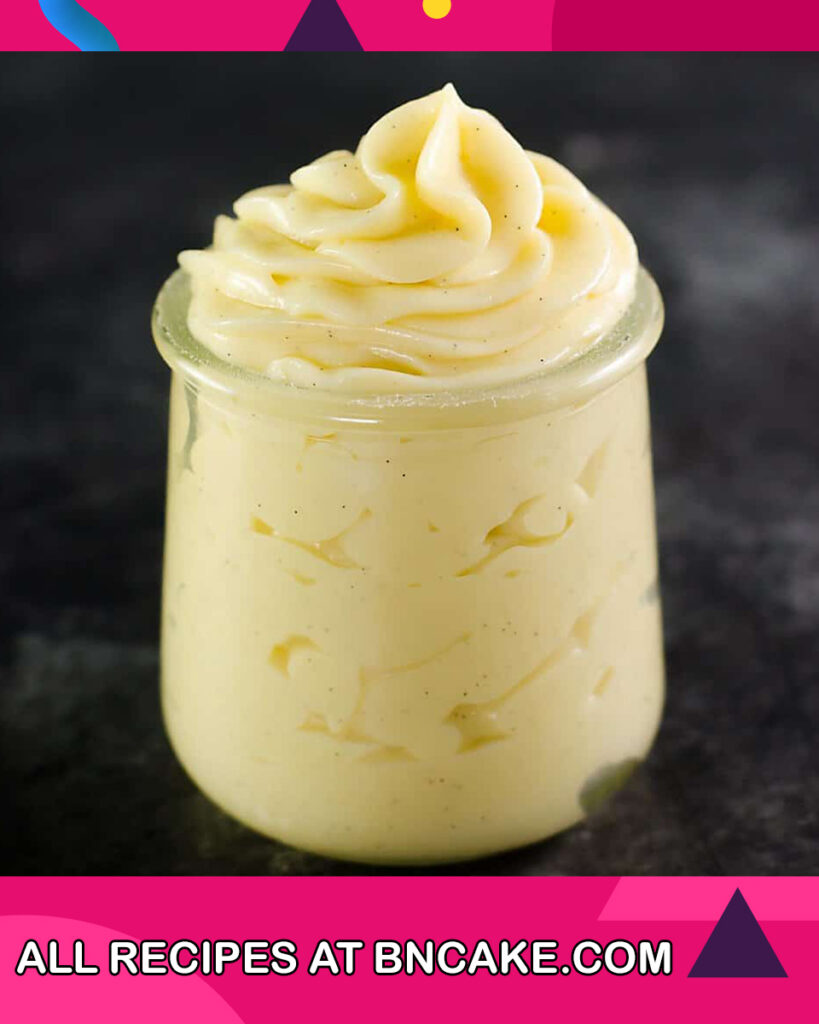
FAQs And Troubleshooting
FAQs:
- Can I use a different type of milk?
While whole milk is traditional, you can experiment with other types of milk, like 2% or even heavy cream, to achieve different levels of richness and creaminess. - Why did my pastry cream turn lumpy?
Lumps can form if the egg mixture isn’t tempered properly with the warm milk. Gradually add the milk while whisking vigorously to prevent curdling. - Can I make the pastry cream ahead of time?
Yes, you can make French Pastry Cream ahead of time. Keep it in an airtight container in the refrigerator and give it a good stir before using. - Why is my pastry cream too thin?
Pastry cream might turn out too thin if it’s not cooked long enough. Ensure you cook it until it’s thickened to a custard-like consistency before removing from the heat. - How can I fix curdled pastry cream?
If your pastry cream curdles, you can try blending it with an immersion blender to smooth out the texture. Straining it through a fine mesh sieve can also help. - Can I freeze pastry cream?
While it’s possible to freeze pastry cream, the texture might change slightly upon thawing. It’s best used as a filling in recipes after freezing.
Troubleshooting:
- My pastry cream is too thick. What should I do?
If your pastry cream is too thick, you can whisk in a small amount of milk, a tablespoon at a time, until you reach the desired consistency. - Why does my pastry cream have a grainy texture?
A grainy texture might result from not fully dissolving the sugar in the egg mixture. Make sure to whisk the egg yolks and sugar until smooth and pale. - Why is my pastry cream too runny?
If your pastry cream is too runny, it might not have been cooked long enough. Continue cooking and whisking until it thickens to the right consistency. - Why did my pastry cream develop a skin after cooling?
A skin can form on the surface if the pastry cream is exposed to air while cooling. To prevent this, press plastic wrap directly onto the surface before refrigerating. - Why does my pastry cream taste eggy?
A strong eggy taste might result from overcooking the pastry cream or not tempering the eggs properly. Be sure to cook the mixture until it thickens, but not too long. - Why did my pastry cream turn out too sweet?
If your pastry cream is too sweet, you can reduce the amount of sugar in the recipe or adjust the quantity to taste next time you make it.
Remember that working with pastry cream might require some practice, but don’t be discouraged by minor setbacks. Each attempt is a chance to learn and improve your technique, resulting in even more delicious French Pastry Cream for your delightful creations.
Nutrition Information
The nutritional information for French Pastry Cream can vary based on the specific recipe and quantities of ingredients used. However, I can provide you with a general estimate of the nutritional values for a typical serving of French Pastry Cream based on common ingredients. Keep in mind that these values are approximate and can vary based on specific preparations and variations.
Please note that these values are for a typical serving of French Pastry Cream, which is around 1/4 cup:
Serving Size: 1/4 cup, Calories: ~150-180 calories, Total Fat: ~8-10g, Saturated Fat: ~4-5g, Cholesterol: ~100-120mg, Sodium: ~25-40mg, Total Carbohydrates: ~15-20g, Dietary Fiber: ~0g, Sugars: ~12-15g, Protein: ~3-4g
Please keep in mind that these values are only estimates and can vary based on the specific ingredients you use and the portion size you serve. Since French Pastry Cream is often used as a component in other desserts, it’s important to consider the total nutritional content of the final dish if you’re tracking your dietary intake. If you’re looking for precise nutritional information, it’s recommended to use a nutritional calculator or consult with a registered dietitian.

